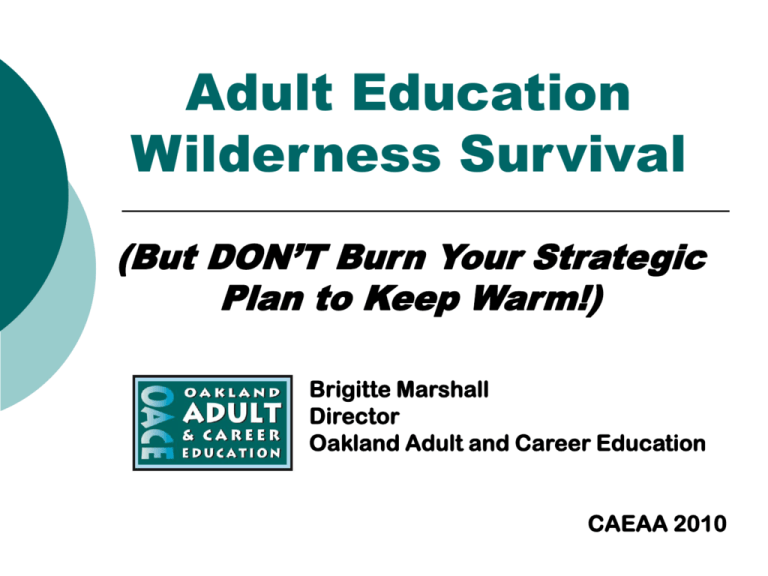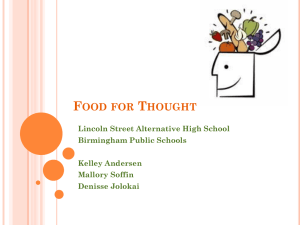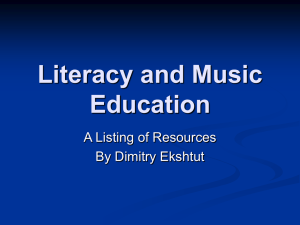PowerPoint
advertisement

Adult Education Wilderness Survival (But DON’T Burn Your Strategic Plan to Keep Warm!) Brigitte Marshall Director Oakland Adult and Career Education CAEAA 2010 Current Situation of CA Adult Education Since passage of the 2009 Budget Act: Adult Education no longer receives protected funding that allows it to operate in an independent and semi-autonomous way Adult Education is now lost in the wilderness, one of many departments within K-12 districts, competing for increasingly scarce resources The future existence of a statewide adult education service delivery system is in jeopardy. On a district-by-district basis we are employing a wide variety of short-term, wilderness survival strategies in an effort to preserve adult education within our communities. Wilderness Survival Strategies o District Services CPR for district staff Administrative assistant training programs Custodial training programs Drop out prevention initiatives CAHSEE non-passers (Valenzuela requirement) Training for paraprofessionals to meet NCLB requirements ServSafe training for district cafeteria workers Parent Information workshops o Cost neutral to the district – do whatever generates revenue and pays for itself o Courting influential community voices and voters Community interest classes and support for parcel tax Cut ESL because “those people don’t vote” What Are We Preserving By Weighting Resources in This Way? Even as we scramble to survive, we must ask the following questions: 1. What are we preserving? Do these services respond to an appropriate mandate? 2. What are the risks attached to our various survival strategies – are we burning the map that shows the way out of the wilderness to stay warm? 2013 is approaching – are we ready? Are we strategically positioned for a new future for California Adult Education? Can We “Step up” Without Stepping Off? Possible consequences of Adult Education programs redirecting their own resources in anticipation of district prioritizing: Dilution of Adult Education programming into the K-12 agenda to the point of ineffectiveness Loss of the critical focus of Adult Education on highest-needs populations Adult Education in name only – really just a set of district services Reframing the Discussion If we are to have any hope of a future statewide adult education service delivery system, we must make the case that Adult Education cannot be marginalized within the context of the K-12 system 1. Identify the highest stakes foundational literacy and workforce development needs in our community which the Adult Education service delivery system is very well-positioned to address. 2. Demonstrate that Adult Education is a vital component of the workforce development system. 3. Demonstrate clearly and consistently that responding to community needs with ongoing commitment of funds to Adult Education services is critically important to the success of our districts and their mission to ensure equitable outcomes for all children. Will the End Justify the Means or Will the Means Define the End? o Adult Education administrators have demonstrated admirable creativity and nimbleness in quickly aligning with K-12– but we should be cautious, aware and protective of the ratio of programming that is emerging. o The “end” we seek should not be “keeping programs in place at any price.” o Will staying in existence at the cost of mission, identity and ultimately credibility count as true survival of Adult Education? o We must shift our focus from reacting, and begin to balance expedience with strategy. The OACE Story Approaching the task of navigating and balancing competing pressures Our Primary Assumption Adult education funds should support a service delivery system that provides instructional programming to adults in our community on a priority basis that is responsive to the most pressing, immediate and high stakes needs. Our Challenge Finding the common ground between this stated core mission of Adult Education and the primary focus of Oakland Unified School District – effective education of all children that allows them to achieve equitable outcomes Needs Assessment Results of OACE Strategic Plan This is what faces Oakland: A literacy crisis Under-prepared workforce High proportion of ex-offenders High rates of poverty and unemployment High crime rates High rates of chronic health conditions High numbers of non-English speaking adults East Oakland West Oakland OACE Strategic Plan Key Features Oakland’s critical needs indicate: a necessary focus on ABE/ASE, CTE, Citizenship and ESL for Specific Purposes to address the literacy (and therefore workforce development) crisis among Oakland’s adults, 18+ Early drop out recovery emphasis Focus on preparation for Middle Skill Jobs Integration, Articulation, Course Sequencing Necessary and sufficient support services Priorities 1, 2, and 3: Outcomes Drive Investment Priority 1 - Outcomes with direct, immediate, high-stakes, highleverage impact on employability and/or access to higher education: • GED • High-school diploma • Employment training completion Priority 2 - Outcomes with high-leverage impact on ability to successfully engage as parents, citizens, and workers: • Improved English Language and Literacy skills • Attainment of citizenship • Improved parenting skills Priority 3- Students achieve outcomes that have positive impact on overall quality of life: • • • • Reduced isolation, increased social engagement Maintenance of cognitive skills Maintenance of independent living skills Maintenance of health and wellness Priorities Within Priorities Three Core Considerations (Ranked 1-5) 1. High Stakes, High Leverage, High Impact Outcomes 2. Support for District Goals 3. Generates Additional Revenue • • • • • • • Additional Considerations (*) Benefits from partner agency collaboration Strong outcome data High Volume/Demand Part of a Pathway High need/High Risk/Vulnerable/Hard to Serve Population Demonstrated Labor Market Demand High Curriculum Integrity OACE/Community Partnerships Support Student Services & Job Placement 2010 Orientation Assessment Individual Learning Plan (ILP) (Academic and Career pathways can be direct or, for English learners, coordinated through ESL program) ESL Beg Low ESL for specific purposes Beg High & Above ESL for Parents (CBET) High School Diploma GED Community College Academic & Vocational programs ESL for Citizenship ESL for Health Occupations ESL for Hospitality/ Svc Industry ESL for Construction/ Green Industries ESL for Office Occupations ESL for Trade, Transportation & Logistics CNA Prep CNA/HHA Employment Career Pathway Identification ESL for Academics Optional concurrent ABE classes Intake ESL Beg Literacy Adult Basic Education -prep for higher academic goals or integrated/ concurrent basic skills for career pathways or contextualized basic skills instruction for parents 4-Year College Single point of entry for low-income, low-skilled adults: Culinary Skills Service & Retail Construction Admin Assist Prep ATLAS, etc Admin. Assist Common Ground? We are clear about the necessary future focus of OACE – especially as a significantly down-sized organization How does it fit with the focus of our school district? The predictive power of demographics • High achieving white students • Achievement disparity for sub-groups: o o o African-American Latino English Language Learners The Strategic Position Many educational researchers, including Darling-Hammond and Ball, agree upon the shared nature of influences on learning; half of what impacts the learning of students happens because of what takes place in schools, and half of what impacts their learning takes place because of what happens to them outside of school. The Strategic Position Children in Oakland will… Experience less poverty …if more low-skilled adults in the community… 1. earn high school diplomas, GEDs and job training certificates that prepare them to get and keep a job. 2. are prepared compete in a global economy. 3. go on to higher education. Encounter more role models who demonstrate the value of education have easy access to adult education program offerings. Become better educated students also become better educated. Transfer the value of education to future generations demonstrate engagement in lifelong learning. Experience better health have the opportunity to learn and apply skills in health literacy. Learn more and generate better test results have the opportunity to learn and apply parental supports for homework and study skills. Experience higher motivation for learning are involved in literacy programs. Experience an overall better quality of life function more competently in everyday situations requiring reading, writing and math. Live in a better democracy apply the knowledge and skills learned in Citizenship, EL-Civics and Voter Education. Become smarter users of technology develop computer literacy skills that help them support and direct their children’s technology use. The Strategic Position When significant numbers of adults around them lack a high school diploma and lack the ability to secure and maintain sustainable employment, what hope, vision and motivation for the future do children have? The Strategic Position If a young adult completes his or her high school education within five years of when they would have graduated with their peers, they have an excellent chance of reclaiming their economic potential and competitive earning power. The Strategic Position The core instructional programs we provide to adults in our communities through the Adult Education service delivery system are in direct service to the core mission of K-12 districts. In Oakland, we believe that OACE is a critical part of what it will take for the district to successfully address the educational disparities between white students, and students of color, and English language learners. Summary of Findings – Adult Education Strategic Plan Needs Assessment 2010 1. To support sustainable economic growth and equitable social conditions, California must focus on closing the foundational skills gaps in the working-age adult population. 2. However, the state’s revenue formula for adult education does not allocate funding based on need. 3. Federal policy priorities stress the same core literacy challenges and are evolving to include post-secondary transition and workforce alignment. 4. Adult education must include a focus on work readiness skills and alignment with career-technical education (CTE). Findings ~ continued 5. The Adult Education system has unique strengths for meeting the State’s core literacy, language, and workforce preparation needs. 6. Adult Education can - and must - demonstrate its relevance to the needs of the state. 7. A needs-based approach can be combined with partnerships and additional or alternative funding to serve non-core needs. Growth in California’s Workforce 2007 - 2032 70% 60% (share of Growth) 60% 50% 40% 39% 30% 20% 10% 1% 0% Immigrants Children of Immigrants Other Source: U.S.C. Demographic Futures Project The Impact of Demographic Change on Education “There will be no net gain in our workforce for a long time coming from native-born Americans….And most of our immigrants are coming from populations who are poorly educated…So to maintain our standard of living every working person must be much more productive…and the children of our immigrants will have to be much more productive than their parents.” Source; Tough Choices or Tough Times--NCEE Moving Toward a New Social Contract Children’s Education $$ Seniors’ Pensions Health Care Home Sellers The Cycle of Roles $$ Replacement Workers New Taxpayers New Home Buyers $$ $$ Mature Adults Offer Maximum Financial Contributions Source: Myers, Immigrants and Boomers Are We Ready? What we do to survive while we are in the wilderness will directly impact our ability to make it back and to thrive once we have navigated our way back to civilization. Don’t burn your strategic plan to keep warm! Are we collectively, strategically positioned to build a sustainable, statewide adult education service delivery system?



